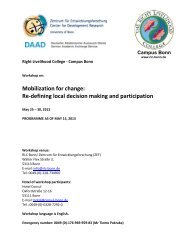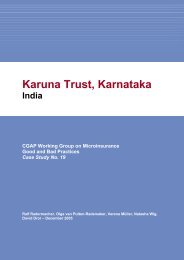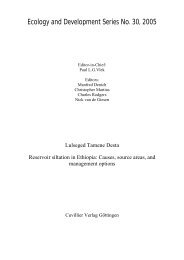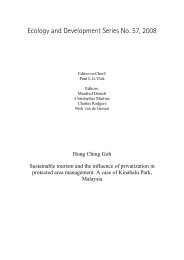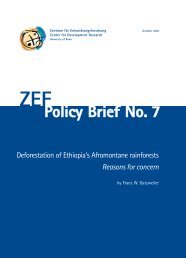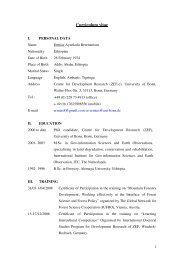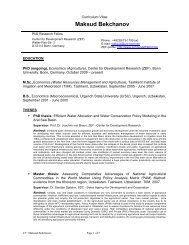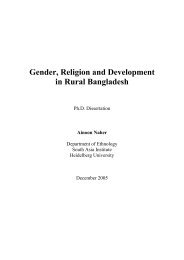Feuer 09 PhD Proposal web - ZEF
Feuer 09 PhD Proposal web - ZEF
Feuer 09 PhD Proposal web - ZEF
- No tags were found...
You also want an ePaper? Increase the reach of your titles
YUMPU automatically turns print PDFs into web optimized ePapers that Google loves.
Hart <strong>Feuer</strong>, <strong>PhD</strong> Research <strong>Proposal</strong>Mr. Hart Nadav <strong>Feuer</strong>Junior Researcher, <strong>ZEF</strong>Center for Development Research (<strong>ZEF</strong>)University of Bonn, Germany30 May 20<strong>09</strong>Research <strong>Proposal</strong> – Not for Citation!Home University:c/o <strong>ZEF</strong>cWalter-Flex-Strasse 353113 BonnGermanySUMMARYIn the Field:c/o CENTDOR71D Street 186Sangkat Touk LaorkKhan Toul KorkPhnom Penh, CambodiaEmail: hfeuer@uni-bonn.deEmail: hfeuer@gmail.comTel: +49 160 9303 9908 (GER)Tel: +855 97 899 0783 (CAM)There is a growing concern that the technological regime of agricultural production and foodconsumption implicit in the modernizationist ideal of development is not socially or ecologicallysustainable. This research focuses then on how developing countries with a predominantly premodernagricultural sector explore divergent food economies in light of domestic conditions andincreasingly divided international debates about agricultural development. Connected to this isthe concept of ecological modernization, which, for developed countries, has largely beenviewed (and experienced) as a post-industrial 1 trajectory of development, predicated primarilyon “superindustrialization” of pollution control through technological advancement (Huber,1982, 1984, 1985; Murphy, 2000). In the food sector, however, post-industrial activities havecommonly taken the form of de-technologization that imply a concomitant return to naturalcultivation and local food networks (Clarke et al., 2008; Jarosz, 2008; Norberg-Hodge et al.,2002; Pollan, 2006; J.D. Van der Ploeg & Renting, 2004). 2 This feature suggests that a preindustrialform of ecological modernization would be possible in the food sector of certaindeveloping countries. Applying the concept of ecological modernization to food systems in apre-industrial context, however, requires an investigation of socially-guided technologicaldevelopment and the cultural politics of food rather than a study on superindustrialization(Murphy, 2000).In a poor country like Cambodia, the rapidly growing interest in and uptake of emergingagroecological cultivation techniques, green marketing, and ethical consumerism presents aparticularly good opportunity to investigate the dynamics of ecological modernization embeddedin pre-industrial sociotechnical evolution. The proposed research will address the emergingsocial acceptance and market embeddedness of sustainably grown and organic rice and palmsugar, as well as “traditional” agri-products, such as medicines and cosmetics. For this study,these products are referred to as socionatural hybrids, a term coined by Latour (1993) to denotephysical manifestations imbued with the social, ethical and ecological processes that went intotheir making. The primary research question is, whether the growing preeminence ofsocionatural hybrids and their concomitant production, marketing and consumer tendencies inCambodia since the mid 1990s are indicative of a novel trajectory for agricultural developmentor whether they are unrelated and distinct shifts within a constraining (industrial) social andtechnological regime?1 For this research, post and pre-industrial refer on a sectoral basis to the extent to which a technological regime foragriculture has become dominant in production systems, public policy, and social expectations (R. F. White &Jacques, 1995). Because every country will experience agricultural development differently, an agricultural sectorthat is still primarily pre-modern and undecided about its industrial trajectory is considers to be pre-industrial.2 On the one hand, considering the advancements in crop biotechnology, post-industrial agriculture could also beseen in the traditional “superindustrialization” sense envisioned by Huber. On the other hand, biotechnology couldalso simply be seen as an extension of industrialization, which is how I view the situation.1
Hart <strong>Feuer</strong>, <strong>PhD</strong> Research <strong>Proposal</strong>A proposal for:Pre-industrial Ecological Modernization in Agriculture?The Role of Socionatural Hybrids in CambodiaBy Hart Nadav <strong>Feuer</strong>TABLE OF CONTENTS1. Physical Background1.1. Agrarian Change in Cambodia1.1.1. Pre-1960s to 19921.1.2. 1992 to Present Day1.1.3. Present Day and Looking Forward1.2. Socionatural Hybrids in Cambodia1.2.1. Rice1.2.2. Palm1.2.3. Traditional Agri-products2. Theoretical Background2.1. Contemporary Views on Sustainable Agricultural2.1.1. Agroecology2.2. Ecological Modernization2.3. Social Sustainability3. Theoretical Framework and Methodology3.1. Critical Realism with Conceptual Aid from Actor-Network Theory3.1.1. Recursive Innovation3.1.2. Transfiguration of Imagery3.1.3. Strategic Niche Formation3.2. Methodology4. Research Questions and Sub-Questions5. BibliographyKeywords: post-industrialism, post-productivism, ethical consumerism, sustainable agriculture,alternative agriculture, green marketing, niche management, ecological modernization, organic2
Hart <strong>Feuer</strong>, <strong>PhD</strong> Research <strong>Proposal</strong>1.1 Agrarian Change in Cambodia1.1.1 Pre-1960s to 19921.0 PHYSICAL BACKGROUNDPrior to the international military intervention and subsequent civil war in the 1960s and1970s, Cambodia was renowned for rice and vegetable production and quality in mainlandSoutheast Asia. A combination of proportionately large areas suitable for cultivation and thehydrological productivity of the Tonle Sap Lake and Mekong catchment meant that Cambodiawould have been ripe for green revolution agricultural development (Vickery, 1992). In 1975,however, the utopian regime of Democratic Kampuchea (i.e., the Khmer Rouge) gained controlof the country and Cambodia effectively became isolated from much of the world. In a broadlystructural sense, the effects on Cambodian agriculture have been immense. Urban citizens wereforced into the countryside and an agrarian social-economy based on traditional (and essentiallyorganic) agriculture predominated until the Khmer Rouge were deposed by the Vietnamese in1979 (Chandler, 2000). As urban areas repopulated, sporadic elements of “modern” agriculturebegan filtering into Cambodia largely without any comprehensive vision in place for agriculturaldevelopment. Casual (and usually uninformed) uptake of mineral fertilizers and pesticides byindividuals became widespread (EJF, 2002; Koma et al., 2000) but these were not part of anoverarching paradigm in Cambodia. And in the absence of institutions and path-dependentpractices such as varietal narrowing, land consolidation, mechanized farming, large-scaleinfrastructure, and export-orientation, green revolution agriculture never took root in Cambodia.And due to poverty and isolation, many farmers continue to be “organic” by default (Makarady,12-15 December 2007). Indeed, the view that Cambodia is in a unique position has permeated tointernational media:“The ensuing poverty [from the civil war] and failure to adopt modern agriculturalmethods could actually give the country an edge, as it and other South East Asian countries gearup for an organic future.” (BBC News, de Launey, 6 March 20<strong>09</strong> 2005)1.1.2 1992 to Present DayAlthough the foregoing narrative is rather essentialist, it is important to set out thestructural characteristics leading up to the 1990s, whereafter Cambodia, as an independententity, began laying new groundwork for agricultural development. Coinciding with andfollowing from the United Nations-sponsored elections in the early 1990s, the internationalcommunity began having direct access to Cambodia. This time period is critical, becausealready by this point in evolution of discourse in agricultural development, green revolutionagriculture had changed its approach somewhat and it had also lost considerable ground toalternative development models focusing on ecological sustainability, empowerment, locality,and diversity. Notably, modernist institutions such as the Cambodian Agricultural Developmentand Research Institute (CARDI) and the alternative-oriented Cambodian Center for Study andDevelopment in Agriculture (CEDAC) began operations around the same time. As a result,modernist agricultural development discourse has weaker than in the 1970s and its relationshipwith alternative development in agriculture has been less polarized than it would have been inprior decades. Functionally, this has resulted in agronomy programs in the University beingmore sympathetic to non-mainstream curricula and the government being supportive of a widerrange of agricultural development models (<strong>Feuer</strong>, 2007). Paralleling these institutional3
Hart <strong>Feuer</strong>, <strong>PhD</strong> Research <strong>Proposal</strong>characteristics at the social scale, it is important to point out that wet-markets and direct farmermarketing still make up the majority of agricultural transactions.1.1.3 Present Day and Looking ForwardAlready, these historical conditions have meant that Cambodia has tended towards morepost-industrial agricultural production than the surrounding countries. Official statisticsprovided by the International Federation of Organic Agriculture Movements (IFOAM) reportthat 0.21% of the agricultural production in Cambodia is organic, which is already higher thanneighboring Thailand, Laos, and Vietnam (IFOAM & FiBL, 2008). More importantly for thefuture however are indicators from CEDAC and my previous research that suggest that roughly35-75% of the production might be unofficially organic (<strong>Feuer</strong>, 2007). 3 On an institutionallevel, momentum for alternative agriculture has also risen considerably with the strong growthof CEDAC, which already reaches more than 5% of farmers and could be expected to reach 25%by 2015. Consumers in Cambodia are also playing a large role in this; despite low incomes, thedemand for organic products considerably outstrips supply and Cambodia is showing signs thata culture of ‘domestic consumption’ founded on quality, patriotism and self-sufficiency hasemerged (Vida & Reardon, 2008), which is reminiscent of local food movements in developedcountries.1.2 Socionatural HybridsThis paper focuses on the respective sociotechnical systems for production, marketing,and consumption of organics, palm sugar and “traditional agri-products”, which includemedicines and cosmetics originating from unrefined natural sources in Cambodia or SoutheastAsia. These and other such products are referred to in this study as agricultural socionaturalhybrids (following Latour, 1993), which I define more specifically as the physicalmanifestations of the remaking of food production-consumption relationships in accordancewith novel ways of imagining better food networks. 4 The inclusion of these three categories inthis study is strategic, insofar as these agricultural products either play disproportionate roles inthe overall agricultural system in Cambodia or are of significant concern for studying the socialvalues of pre-modern artifacts. Perhaps more importantly, however, these three categories havealready been the targets of significant engagement by civil society in cultivation, promotion,conservation, and marketing. The main characteristics of these socionatural hybrids aresummarized below, with detail in subsequent sections:- Organics, and particularly rice, are usually mainstream agricultural products whoseproduction is industrialized in many other countries but are now targets ofagroecological reinvention and new marketing systems.- Palm sugar is a treasured traditional product with importance for local cuisine andcottage industry. Palm processing has increasingly become industrialized with itsbroader penetration into urban markets, which threatens its nutritional utility andworsens its ecological impact.- Traditional medicinal and cosmetic agri-products, still mainstays of the Cambodianhealth system, influence consumer acceptance of chemically derived products andunsustainably procured ingredients.3 It is important to point out that for IFOAM, “organic” generally refers to a conscious attempt made by farmers tofollow organic principles and is not a default category for farmers not employing chemical inputs.4 Notable examples of socionatural hybrids include organic, “traditional”, Fairtrade, and local products. Theappellations, such as “organic”, are themselves not socionatural hybrids—only a product itself.4
Hart <strong>Feuer</strong>, <strong>PhD</strong> Research <strong>Proposal</strong>1.2.1 RiceThe emergence of various agroecological techniques, such as the System of RiceIntensification (SRI), multi-purpose farming and ecological livestock raising, havesimultaneously provided a potential avenue for farmers to (a) increase productivity, (b) gainaccess to niche markets for organic and local produce, and (c) decrease environmentaldegradation. In Cambodia, in particular, the success of the Cambodian Center for Study andResearch in Agriculture (CEDAC) and Srer Khmer in the extension of SRI and promotion ofgreen marketing initiatives (i.e. my previous research, and CEDAC, 2007) has increasinglydemonstrated the potential for sustainable production and consumption to be merged. TheNatural Agri-Product (NAP) brand, developed by CEDAC, has extended into the organiccertification of plant and livestock products, non-chemical preservation, and natural foodrestaurants. The German Technical Cooperation (GTZ) and German Development Service(DED) have invested expertise in testing and internationalizing these standards as well asmeasuring market characteristics. At the present time, the domestic demand for organic certifiedproducts and ‘natural’ foods outstrips supply by a significant degree, despite the relative povertyof Cambodia (compared to Thailand and Vietnam).1.2.2 Palm SugarThe successful spillover effect from promoting organics (particularly rice, a mainstreammega crop) onto other moderately important agricultural products, such as palm, has hinted atthe possibility for larger-scale inclusion of other agricultural products propelled by producer andconsumer support. Palm products, particularly palm sugar, have transcended the countrysideand received much attention from industrial producers, the primary result of which, in additionto widespread market diffusion, has been miniaturized packaging and introduction of chemicaladditives for color preservation. Palm, however, is still commonly seen as a “traditional”product and demand is growing for authentic and natural forms. Initiatives for sustainability ofpalm products, which have largely been advanced by the same parties promoting organiccertified rice and livestock, have included non-chemical preservation and packaging intraditional earthenware pots.1.2.3 Traditional Agri-productsMany other “traditional” products, particularly medicines and cosmetics, are alsobeginning to be appreciated locally on two levels experienced in post-industrial environmentaland health discourses. On one level, medicines and cosmetics derived from largely unrefinedand natural origins are increasingly being viewed as healthier alternatives to their chemicalbasedcounterparts. On another level, awareness and consumer action concerning the trade inrare and endangered species used in traditional medicine and cosmetics has increased thedemand for sustainably-procured ingredients and increased the pressure to stop illegal orirresponsible harvesting.2.0 THEORETICAL BACKGROUND2.1 Contemporary Views on Sustainable Agriculture and Rural DevelopmentIn development discourse, the concept of sustainability has grown to encompass a widerange of ideas and practices, ranging from specific methods for improving eco-efficiency tobroad theories concerning how to (re)structure consumer society (Jacobs, 1999; Lélé, 1991;O'Riordan, 1981; 1989; O'Riordan & Voisey, 1997; Tripp, 2006; UNCED, 1992a: Section II,5
Hart <strong>Feuer</strong>, <strong>PhD</strong> Research <strong>Proposal</strong>1992b). The earliest paradigm of agricultural sustainability was largely normative in nature,emerging from atavistic notions about returning to nature, simpler lives and honoring rural farmheritage (cf. Leopold, 1981; L. White, 1967; Wilson, 1996). The collective struggles of animalrights activists, family and artisan farmers, discriminating consumers and concernedagriculturalists have laid the preliminary foundation for markets for sustainable products andarticulated a post-industrial 5 vision of agricultural production that deliberately resembles premodernagriculture (Clarke et al., 2008; Singer, 1974). Unsurprisingly, post-industrialconceptions of agricultural have often come to be seen as uniquely commensurate with ruraldevelopment programs in impoverished areas and have thus become quite common indevelopment practice.The structural dynamic assumedly underlying such visions for agricultural developmentis that the developing countries, having begun agricultural industrialization later, have a cadre offarmers who are in a structural position to embark directly on a novel trajectory of agriculturaldevelopment. Implied in such conceptions of rural and agricultural development is the hopethat, in the name of food security, ecological diversity, environmental protection, and health,farmers in developing countries might leapfrog the unsustainable path taken by industrializedcountries. The opportunities for farmers involved in this movement include gaining access toprivileged market structures such as Fairtrade and organic, improving eco-efficiency, reversingdeleterious health effects of agricultural chemicals and pollutants, facilitating local coordinationand governance, and retaining indigenous culture. For consumers, this is a chance to movedirectly to post-industrial consumption ideals, epitomized in particular by wholesome, healthy,diverse, locally-supportive, indigenous, and chemical-free food (Bawden, 1991: 2363-2364;Chambers et al., 1989: xvii-xx).The heterodox or “alternative” food and agricultural systems emerging since the 1960s inpost-industrial contexts have evolved in form and shape to compromise quite a large spectrum ofwhat Holloway et al. (2007) calls “new food economies”. They range from revolutionary andoppositional food systems aspiring to make fundamental changes in production methods, supplychains, consumer interaction, and identity to more modest revisions of cultivation techniques.Holloway et al. argue that it is important to see this spectrum not as a bipolar oppositionbetween conventional and radical, but rather multi-polar, with different heuristic analytical fieldsconstituting forums for differentiation and/or opposition. In J.D. van der Ploeg’s (1996) accountof the heterogeneity of European farming, the individual and subtle level of differentiationbetween various “styles” of farming production demonstrates that diversity in agriculturalsystems exists even in the assumedly fully commoditized western European agricultural zone.In light of the seemingly neutral diversity found among food production-consumptionsystems, I argue that the discourses from which most transformative visions for new foodeconomies emerge are oppositional in nature. Although I am as disinclined to use theterminology of “alternative agriculture” as Holloway et al. (2007), I recognize that the larger“political project” behind organics, ‘slow food’ movements, and community-supportedagriculture continues to be focused on supplanting an entrenched sociotechnical regime foragriculture. In other words, although neutral differentiation between food economies is possible,this is not ground for de-politicizing movements that have emerged from primarily reactionaryand oppositional discourse. In any case, while these mostly post-industrialist movements haveinserted small wedges in the global agricultural system and initiated fruitful discussion, theyhave lacked the teeth to uproot the dominant technological regime sustaining modernist and‘green revolution’ agriculture in developed countries. Since the mid 1990s, however,5 Post-industrial, as it is used here, refers to the values and systems (for agricultural production and consumption)that are commonly associated with the orientation on environment and health found in many industrializedcountries in the North. Post-industrial ideals are not exclusive to those living in post-industrial societies, especiallyconsidering that many of these ideals are a harkening back to pre-modern values and systems which are oftenshared by members of developing countries.6
Hart <strong>Feuer</strong>, <strong>PhD</strong> Research <strong>Proposal</strong>sustainable development discourse has made developing countries an arena in which moreradical visions for restructuring food economies might be realized.2.1.1 AgroecologyAt the intersection of sustainable agriculture and rural development lies agroecology,which is primarily the application of ecological principles to agricultural science. Firstintroduced by Miguel Altieri (1987), agroecology has increasingly come to symbolize resistance(against the strict scientific rationality of agronomy) and cooptation (of scientific methods forecological purposes). Although extant long before in the works of K.H.W. Klages (1928), thecontemporary support for agroecology grew out of dissatisfaction with green revolution (highexternal-input) systems of cultivation and social organization (Fernandes et al., 2002). As such,it is a science that is fairly reactionary in nature and often bundled with new methodologicalconsiderations, such as participation and empowerment. In part, agroecologists seek not only toundo the damage wrought by industrialized and green revolution cultivation practices and landmanagement techniques, but also to foment a paradigm shift in rural development as a whole(Francis et al., 2003). Many agroecologists, as a result, are not natural scientists oragriculturalists, but social scientists. 6 And while adhering to the normative agenda ofenvironmental sustainability, agroecology is keenly aware of the extent to which the time frame,structural (and market) constraints, and extension/learning techniques must be accommodated inorder to see paradigm-wide changes.2.2 Ecological ModernizationIn the early 1980s, Joseph Huber introduced the concept of ecological modernization toilluminate trends environmental protection based on the experience of Western Europe (Huber,1982, 1984, 1985). He expounded a view that environmental problems could be addressedthrough “superindustrialisation”—using more sophisticated industrial technology to reducepollution. In addition, he posited that ecological modernization was a phase that followed theconstruction of industrial society (1848-1980) (Murphy, 2000). He viewed the economy andtechnology as the driving forces during industrialization, while the subsequent stage was drivenby the need to reconcile the impacts of human economic activity with the environment. Huberargued that, in this process, new social movements, such as the environmental movement, andeven government, had a limited role to play in bringing about this transformation. Instead, hesaw economic actors and entrepreneurs as the most important influences.The original formulation of ecological modernization has since been critiqued, revised,and expanded with additional theorizing and empirical evidence from countries not consideredby Huber. Notably, there is now a broad agreement that there is indeed a role for government toplay. Additionally, dimensions of ecological modernization have also been introduced,particularly those involving cultural politics and discourse (Murphy, 2000). Ecologicalmodernization has come to be seen as more path dependent (i.e., historically contingent) andsocially constructed, reflecting a society’s relationship with scientific advancement and itstolerance for risk (Giddens, 1990, 1991). Largely, these re-formulations continue to be focusedon macro-level processes observed in post-industrial contexts. By viewing it sectorally,however, ecological modern can be distilled down to more concrete processes and ideas, fromwhich a more nuanced and empirically robust outline of this transformation can be viewed. Inthis research, then, I aim to look at the sector of agriculture in a pre-industrial context, in orderto explore how or if ecological modernization can be utilized as a strategy for sustainable6 See, for example, the edited volume by Norman Uphoff (2002), the director of the Cornell International Institutefor Food and Agricultural Development (himself a social scientist). Contributors to the volume were spread fairlyequally between agricultural scientists, NGO leaders, and social scientists of various disciplines.7
Hart <strong>Feuer</strong>, <strong>PhD</strong> Research <strong>Proposal</strong>development. There is reason to believe that the agricultural sector, particularly in a country likeCambodia, could experience a sectoral form ecological modernization prior to or instead ofindustrialization. As Henderson (1998) has argued, the agricultural sector is less readilysubsumed into capitalist relations, because is based in nature and nature (i.e., land and growthdynamics) does not inhere the circulative properties of capital common to other industries. 7Indeed, even Marx (19<strong>09</strong>: 241) has acknowledged that agricultural production is largelyexpected to combine with subsidiary rural industries in order to form capitalist productioncycles, as it is not absorbed into capitalist relations on its own.2.3 Social SustainabilityThe development of niche-scale new food economies in developed countries hasdemonstrated that values and social institutions rather than the advancement of agriculturaltechnology are the main drivers of new sustainability initiatives in agriculture. Indeed, theinvestments into research in organic agriculture are very small relative to the interest [citation,Bonn Univ Organic Studies Group]. It is been largely at the confluence of the post-industrialfarmer’s and consumer’s environmental ideology and health concerns that the demand andproduction systems for novel food networks have emerged. Crop scientists have contributed tothis as well, mainly by expounding various management systems (such as Integrated PestManagement), outlining causes of and mitigation techniques for soil nutrient loss, and producing“natural” fertilizers and pest control compounds. In general, however, the production,consumption, and interface system of new food economies are based on modifying the socialexperience and everyday practices of farming and buying, rather than advancing the technicalsystem. In contrast to the Huberian model of ecological modernization, human and socialcapital, and not technological advancement, are the primary agents of change. Thesecharacteristics of new food economies, combined with the structural similarities between postindustrialand pre-modern agriculture, makes them particularly viable in many developingcountries.The primarily social basis of new food economies, however, means that a sense ofsustainability emerges without necessarily creating a strict, scientifically verifiable ecologicalreality. Nevertheless, exploring novel food economies can push society towards the socialreadiness to accept scientifically approved ecological sustainability when it comes down thepipeline. Illusions can be instrumental in this sense. “Organic/Bio” is a lifestyle symbol (Evers& Gerke, 1997), as much as it is a technical standard/certification (Campbell & Liepins, 2002).The Fairtrade system, likewise, has been a large experiment that has generated a dialogue aboutits brand of ‘production system’ and thereby pushed research to evaluate its in a much moreeffective fashion. Furthermore, agroecological production systems such as the System of RiceIntensification, which are not yet scientifically verified, 8 have been shown (in Cambodia) to bevery useful nevertheless in building participatory rural development projects around them(<strong>Feuer</strong>, 2007). 97 Henderson is primarily summarizing here the so-called ‘Mann-Dickinson thesis’ (1978), which posits that nature,in her various manifestations (land, weather, crop growth dynamics, etc.), is an obstacle to the full absorption intocapitalist relations. Henderson goes further to argue that the impediment is furthered by the artificial creation of socalled“fictitious capital”, or productive value unjustifiably predicted from the highly variable, natural conditionsinherent to cultivation.8 There is an ongoing collaboration between the University of Wageningen (the Netherlands) the CornellInternational Institute for Food, Agricultural Development (CIIFAD, USA), and the International Rice ResearchInstitute (IRRI, the Philippines) to “settle” once and for all whether or not SRI improves yields in a sustainablefashion.9 Due to the limitations of scope and the researcher’s capacity, this work is not poised to verify or discredit thescientific (ecological) sustainability of any particular production system.8
Hart <strong>Feuer</strong>, <strong>PhD</strong> Research <strong>Proposal</strong>3.0 THEORETICAL FRAMEWORK AND METHODOLOGY3.1 Critical Realism with Conceptual Aid from Actor-Network TheoryThis research is concerned with the creation and evolution of sectoral networks for thepromotion of socionatural hybrids, or agri-products that are driving the development of a newfood economy in Cambodia. By treating these socionatural hybrids and their networks asconcrete objects and exploring the socially constructed nature of the concepts behind thesesocionatural hybrids (Sayer, 1993), this research adopts a critical realist stance in its view ofecological modernization. Ecological rice, traditional palm sugar, and natural-traditional healthand bodycare are already manifest in Cambodia and their form is similar to socionatural hybridsemerging out of post-industrial contexts and alternative agricultural movements. The questionsto raise at this point regard the significance of the extent of these socionatural hybrids inCambodia and the ideas being transmitted through the production, marketing and consumptionof these products. In order to explore the people, products, and places relevant to theseproducts, I use a specific set of methodological tools from Actor-Network Theory to understandthe evolution of the networks of production, marketing and consumption. Although ANT wasinitially employed as a theoretical and methodological frame for untangling the messyrelationship between the hard sciences and their social embeddedness (Callon, 1980, 1986;Callon & Latour, 1981; Latour, 1987, 1988), it has increasingly been used to analyzeinstitutional behavior, the sociotechnical nature of (development) ‘projects’ parented byorganizations, and the non-human objects and technologies which mediate network functioning(Callon, 1991; Latour, 2004, 2005).Central to the understanding of ANT is the concept of ‘translation’, which is a manner ofimposed collaboration by which actors enroll others into, or maintain their presence in, an‘actor-world’. Actor-worlds, which are often conflated with ‘social networks’, are operationalspaces within which actors continually renegotiate their roles and redefine the scenario of theirfunctionality. ANT studies often conclude that, indeed, the result of aggregate translationexercises is the maintenance the coherence of various actor-worlds. This study, however, isfocused on the meaning of the strategies and methods used to recruit into the network and thestrength of the translation relative to competing agricultural paradigms. In other words, theideas being employed to enroll actors into an actor-world, be they environmentalism or health,are not viewed only instrumentally for their ability to enroll, but for their significance within aframework of ecological modernization.The specific methodological-theoretical tools from actor-network theory that I use are:- Recursive innovation. Defined as the co-evolution of markets and preferences withnew technologies, recursive innovation is an attempt to serve the means/practices ofother social worlds (mostly users and appliers) from the onset of development (Geels,2002; Rammert, 2001).- Transfiguration of Imagery. Coined by Allaire and Wolf (2004), this refers to theprocesses by which socionatural hybrids “hitchhike” on intermediary symbols or preexistingproducts that have familiarity and meaning to end-users.- Niche Formation. The process by which niches, or protective spaces forexperimentation and articulation, form around new technologies in order todetermine their viability in a less constraining sociotechnical regime (Hoogma et al.,2002; Hoogma et al., 2005). In this study, Cambodia is viewed as a niche within theworldwide technological regime for food, and development projects are viewed as aniche within the Cambodian agricultural regime (Murdoch et al., 2000).9
Hart <strong>Feuer</strong>, <strong>PhD</strong> Research <strong>Proposal</strong>3.2 MethodologyThe heterogeneity of research objectives inherent to this study necessitates a highly multidisciplinaryapproach. Below, I describe which data types I intend to gather and expound uponthe methodology for each gathering and the theoretical relevance.1. Market Information System (Recursive Innovation, Niche Formation). In order tounderstand the market trends accompanying the changes in agricultural production, I willcollaborate with the German Development Service (DED) to create a market informationsystem for certified organic products. The baseline data would comprise volume of salesbased on different certifications, source regions, pricing, timing of purchases/sales, andresale characteristics such as marketing efforts. The data would be refreshed at intervalsbased on seasonality (up to 3 times/year for rice). Indirectly, these data would alsoprovide information on production costs and the growth of organic markets by regionand by certification system. In addition to simple trend analysis, these data would becollected to facilitate an analysis of the market segmentation of the consumers (elite,middle-income, poor) and of the elasticities of demand for the target agri-productscompared to conventional products. The larger econometric question to be answeredwith these data is how the increase in sales/demand for socionatural hybrids (dependentvariable) is associated with independent variables (such as relative cost, price elasticity,proportionate market segmentation, green marketing measures) that explaincomprehensive society-wide change rather than those of specific economic or socialclasses.Sampling will be conducted as follows:a. (Domestic) Assembling a list of all known organic product distributors (based oncertification agencies’ data and retail outlets’ sourcing) and visiting/contactingeach marketer.b. (Export) Data on the export and government policies of certified organic productsand their conventional counterparts would be collected from the Ministry ofCommerce. Destination countries and export handlers would be identifiedcorrespondingly.2. Survey of Values and Preferences (Recursive Innovation, Transfiguration of Imagery).In order to understand how the identity of socionatural hybrids is evolving alongsideconsumer attitudes (Kemp & Rotmans, 2005), it will be necessary to survey individualsat each stage in the commodity chain (or filiere) of the agri-products (Smith et al., 2002).More specifically, farmers, middlemen, resellers, and consumers will be surveyed abouttheir changing perceptions and outlook regarding socionatural hybrids. Particular focuswill be given to members of society on the frontiers of change (e.g., poster-child organicfarmers, NGO members, ministerial officials, rich consumers, etc.) in order to gauge theleading edge of ecological literacy and ethical consumerism. These surveys will be of ahybrid qualitative and quantitative nature, primarily sociological in form, exploring themotivations and behavior of actors directly influencing the demand for and awareness ofsocionatural hybrids.Many such surveys/interviews can be made alongside data collection for the marketinformation system. The approach is loosely based on the commodity chain approaches(Hartwick, 1998), such as Global Commodity Chains, Filieres, Systems of Provision,hybrid approaches (Holloway et al., 2007) and Netchains, as well as the ‘food networks’10
Hart <strong>Feuer</strong>, <strong>PhD</strong> Research <strong>Proposal</strong>approach (Arce & Marsden, 1993), adapted for use in domestic settings (see Raikes etal., 2000).The larger question to be answered is to what degree identities (as constructed by NGOprograms, marketers, and consumers) such as organic, traditional, and authentic areappealing to health concerns, ecological concerns or simply romantic atavism. Althoughthis is primarily a qualitative investigation involving in-depth ethnographic interviewsand group discussions, some significance testing can be used to determine whetherawareness-makers’ intent and consumer views are aligned (Pearson’s chi-square test)and whether these factors are related to sales (ANOVA, using market information systemdata).In order to select respondents, I will use (a) the Market Information System’sinformant pool with further snowball sampling, and (b) my own knowledge of the foodsector based on previous research. Consumers will be the most difficult to sample from– and I am still considering how to sample respectfully and randomly from within shopand marketplace resale groups in order to ensure (some) representation from organicbuyers. Generally, I will carry out interviews and ethnographic work with the followingcategories:- NGO personnel- Farmers (often as group discussions, perhaps in Farmer Associations)- Middlemen (overlaps with NGO personnel sometimes, includes rice millers)- Resale (marketplace)- Resale (shop)- Consumers (domestic)- Government officials- Organics Certification Officers (primarily GTZ, DED, CEDAC, Oxfam America)3. Geographical Idea Map (Niche Formation). In order to study the spatial dimension ofthe spread of awareness of socionatural hybrids, it is imperative to travel extensivelybetween production sites and to determine how and why production systems havemigrated to other areas (Hoogma et al., 2005; Kemp & Rotmans, 2005; Kemp et al.,1998). Have they migrated through market information, rumor, demand, developmentactivities and/or the spread of ecological motivations? I will interview producers andinvestigate cropping patterns to determine how production constraints and environmentalawareness, agricultural extension and rural institutions have mediated for the spread ofniche production techniques all over Cambodia. On the consumer side, I will try to makewhen and why certain market stalls and resale shops took on organic and traditionalproducts. Were there thresholds like the sales success of an NGO organic shop orrestaurant, or the success of certain agroecological techniques in a flagship village? Wasthe spread cumulative, fragmented, or sudden? Which actors were involved in thetransitions and how many resources did they pour into getting what they wanted? Whatthreads and ideas are interwoven into this – such as ideas of modernity, and exposure tomodernized agricultural systems, like HYV see and the availability of agrochemicals.The theoretical background for studying the transition of socio-technical systems andniche formation is discussed by a number of key authors within the field of science andtechnology studies (STS) (Geels, 2005; Geels & Schot, 2007; Hoogma et al., 2002;Kemp et al., 1998).4. Discourse Analysis (Transfiguration of Imagery). Paralleling the changing systems ofagricultural production and evolving views of nature, purity, and authenticity is the11
Hart <strong>Feuer</strong>, <strong>PhD</strong> Research <strong>Proposal</strong>language and frame of reference in which these activities are carried out. High-leveldiscourse concerning sustainability and rural development certainly have a role indefining how NGOs and development agencies specify their activities (Adams, 1995),but this must also meld with two other influential categories of thought in Cambodia:local conceptual space (derived from language, lore and spirituality) and utopian thought(Hedrén, 2008). Mentioned above in regard to interviewing farmers was the concept ofthe “rice goddess”, which is a spiritual and mythical construct with some influence onthe way people conceive of purity and rice cultivation. In my previous research, the cowis often seen as a “member of the family”, which inevitably impinges on livestock raisingpractices and other animal labor activities. Newspapers, radio and television are alsomedia institutions that have quite a reach into the countryside—they form and are formedby discursive practices. Politicians and political campaigns are additional players in theconstruction of imagery. To the extent that such influences change and are beingchanged by the discourses of sustainable development, organic agriculture, tradition andmodernity, they become important explanatory factors for and of paradigmatic changesin society. As a “methodology”, discourse analysis will merely be used as anoverarching interest used and examined in all of the other methodologies explainedabove.12
Hart <strong>Feuer</strong>, <strong>PhD</strong> Research <strong>Proposal</strong>4.0 RESEARCH QUESTIONS AND SUB-QUESTIONS1. (Recursive Innovation) How are food production-consumption systems in Cambodiaevolving to meet the technical and social needs of farmers and consumers in the contextof the diffusion of alternative agricultural systems?a. What is the nature of the heterogeneity of farming practices—flexibility, resourceconstraints, and/or style?b. What is the market segmentation by social/economic class and what are the crosselasticities (i.e., demand is more resistant to price changes) for socionaturalhybrids compared to conventional produce?c. What is the scale of new investment and consumption in the sectors forsocionatural hybrids and is this precedented?2. (Transfiguration of Imagery) What types of production and consumption ideals areattached to socionatural hybrids and how much social currency do they represent?a. What is the scale of marketing efforts for socionatural hybrids and what are thedominant messages contained therein?b. What are the motivations of producers of socionatural hybrids and what identityelements are becoming associated with socionatural hybrids?c. What roles do ecological literacy and understandings of rural life have to play inbuilding the social identities behind socionatural hybrids?3. (Strategic Niche Branching) What is the dynamic behind the diffusion of production andconsumption practices for socionatural hybrids? Viral, decentralized, bottom-up, etc.a. To what degree have alternative cultivation techniques been spread by people andsocial expectations as compared to development interventions?b. Through what channels have messages attached to socionatural hybrids migrated?Market information, rumor, demand, development initiatives, etc.c. To what degree is maintaining the growth in socionatural hybrid cultivation andpromotion dependent upon donor funding and how has independence beenachieved by some actors?d. What is the dynamic of the spreading—is it gradual, cumulative, sudden?—andare there thresholds at which different dynamics begin or end?4. What is the nature of the communication and discourse between actors attached toproduction systems for socionatural hybrids and those of modernist agronomicorientation?a. How do figures within these various institutions (esp. CARDI and CEDAC) seetheir political relationship with the other, and what influence does this have oncooperation, academic exchange and dialogue?b. What is the nature of ideological and practical disagreements? Critical, open,antagonistic, etc.c. Have relations between modernizationist and agroecological institutionsimproved, worsened, or remained unchanged, and upon which controversialissues have the conflicts focused? Where is the common ground?13
Hart <strong>Feuer</strong>, <strong>PhD</strong> Research <strong>Proposal</strong>5.0 BIBLIOGRAPHYAdams, W. M. (1995) 'Green Development Theory? Environmentalism and SustainableDevelopment' in J. Crush (Ed.), Power of Development (pp. 87-100). London:Routledge.Allaire, G., & Wolf, S. A. (2004) 'Cognitive representations and institutional hybridity inagrofood innovation', Science, Technology, & Human Values, 49(4): 431-458.Altieri, M. A. (1987) Agroecology: The Scientific Basis of Alternative Agriculture. Boulder, CO:Westview Press.Arce, A., & Marsden, D. (1993) 'The Social Construction of International Food: A NewResearch Agenda', Economic Geography, 69: 293-312.Bawden, R. J. (1991) 'Systems Thinking and Practice in Agriculture', Journal of Dairy Science,74: 2362-2373.Callon, M. (1980) 'Struggles and Negotiations to define what is the Problematic and what is not:the Sociology of Translation' in K. D. Knorr, R. Krohn & R. D. Whitley (Eds.), TheSocial Process of Scientific Investigations: Sociology of the Sciences Yearbook (Vol. 4,pp. 197-219). Boston: Reidel.Callon, M. (1986) 'Some Elements of a Sociology of Translation: Domestication of the Scallopsand the Fishermen of St Brieuc Bay' in J. Law (Ed.), Power, Action and Belief: A NewSociology of Knowledge. London: Routledge.Callon, M. (1991) 'Techno-economic Networks and Irreversibility' in J. Law (Ed.), A Sociologyof Monsters? Essays on Power, Technology and Domination (Sociological ReviewMonograph) (Vol. 38, pp. 132-161). London: Routledge.Callon, M., & Latour, B. (1981) 'Unscrewing the Big Leviathans: How Do ActorsMacrostructure Reality?' in K. D. Knorr & A. Cicourel (Eds.), Advances in Social Theoryand Methodology: Toward an Integration of Micro and Macro Sociologies (pp. 277-303). London: Routledge.Campbell, H., & Liepins, R. (2002) 'Naming Organics: Understanding Organic Standards inNew Zealand as a Discursive Field', Sociologia Ruralis, 41(1): 22-39.CEDAC. (2007). CEDAC's Contribution to Agriculture and Rural Development in Cambodia.Phnom Penh: Centre d’Étude et de Développement Agricole Cambodgien.Chambers, R., Pacey, A., & Thrupp, L. A. (Eds.). (1989) Farmer First. London: IntermediateTechnology Publications.Chandler, D. (2000) A History of Cambodia. Boulder, Colorado: Westview Press.Clarke, N., Cloke, P., Barnett, C., & Malpass, A. (2008) 'The spaces and ethics of organic food',Journal of Rural Studies, 24: 219-230.14
Hart <strong>Feuer</strong>, <strong>PhD</strong> Research <strong>Proposal</strong>de Launey, G. (2005). Cambodia targets organic market [Electronic Version]. BBC News..http://news.bbc.co.uk/2/hi/asia-pacific/4350290.stmRetrieved 6 March 20<strong>09</strong> fromEJF. (2002). Death in Small Doses: Cambodia's Pesticide Problems and Solutions. London:Environmental Justice Foundation.Evers, H.-D., & Gerke, S. (1997) 'Globalized market culture and market fundamentalism' in R.Fardon, W. van Binsbergen & R. van Dijk (Eds.), Modernity on a shoestring:Dimensions of globalization, consumption and development in Africa and beyond (pp.142-152). The Hague: EIDOS.Fernandes, E., Pell, A., & Uphoff, N. (2002) 'Rethinking Agriculture for New Opportunities' inN. Uphoff (Ed.), Agroecological Innovations: Increasing Food Production withParticipatory Development (pp. 21-39). London: Earthscan.<strong>Feuer</strong>, H. N. (2007). Sustainable Agricultural Techniques and Performance OrientedEmpowerment: An Actor-Network Theory Approach to CEDAC Agricultural andEmpowerment Programmes in Cambodia. Oxford: Department of InternationalDevelopment, University of Oxford.Francis, C., Lieblein, G., Gliessman, S., Breland, T. A., Creamer, N., Harwood, R., et al. (2003)'Agroecology: The Ecology of Food Systems', Journal of Sustainable Agriculture, 22(3):99-118.Geels, F. W. (2002) 'Technological transitions as evolutionary reconfiguration processes: amulti-level perspective and a case-study', Elsevier Research Policy, 31: 1257-1274.Geels, F. W. (2005) 'The dynamics of transitions in socio-technical systems: a multi-levelanalysis of the transition pathway from horse-drawn carriages to automobiles (1860-1930)', Technology Analysis & Strategic Management, 17(4): 445-476.Geels, F. W., & Schot, J. (2007) 'Typology of sociotechnical transition pathways', ResearchPolicy, 36(3): 399-417.Giddens, A. (1990) The Consequences of Modernity. London: Polity Press.Giddens, A. (1991) Modernity and Self-Identity: Self and society in the late modern age.Cambridge: Polity Press.Hartwick, E. R. (1998) 'Geographies of Consumption: a commodity-chain approach',Environment and Planning D: Society and Space, 16(4): 423-437.Hedrén, J. (2008) 'Shaping sustainability: Is there an unreleased potential in utopian thought?'Futures, In Press, Corrected Proof.Henderson, G. (1998) 'Nature and Fictitious Capital: The Historical Geography of an AgrarianQuestion', Antipode, 30(2): 73-118.Holloway, L., Kneafsey, M., Venn, L., Cox, R., Dowler, E., & Tuomainen, H. (2007) 'PossibleFood Economies: a Methodological Framework for Exploring Food Production-Consumption Relationships', Sociologia Ruralis, 47(1): 1-19.15
Hart <strong>Feuer</strong>, <strong>PhD</strong> Research <strong>Proposal</strong>Hoogma, R., Kemp, R., Schot, J., & Truffer, B. (2002) 'Experimenting for SustainableTransport: The approach of Strategic Niche Management' in D. Banister (Ed.),Transport, Development, and Sustainability. New York: Spon Press.Hoogma, R., Weber, M., & Elzen, B. (2005) 'Integrated Long-Term Strategies to Induce RegimeShifts towards Sustainability: The Approach of Strategic Niche Management' in M.Weber & J. Hemmelskamp (Eds.), Towards Environmental Innovation Systems. Berlin:Springer.Huber, J. (1982) Die Verlorene Unschuld der Ökologie: Neue Technologien andSuperindustrielle Entwicklung (The Lost Innocence of Ecology: New Technologies andSuperindustrialized Development). Frankfurt am Main: Fischer Verlag.Huber, J. (1984) Die Zwei Gesichter der Arbeit: Ungenutzte Möglichkeiten der Dualwirtschaft(The Two Faces of Labour: Unused Possibilities of the Dual Economy). Frankfurt amMain: Fischer Verlag.Huber, J. (1985) Die Regenbogengesellschaft: Ökologie und Sozialpolitik (The Rainbow Society:Ecology and Social Politics). Frankfurt am Main: Fischer Verlag.IFOAM, & FiBL. (2008). Organic Agricultural Land Worldwide 2007. Frick, Germany:Research Institute of Organic Agriculture.Jacobs, M. (1999) 'Sustainable Development as a Contested Concept' in A. Dobson (Ed.),Fairness and Futurity: Essays on Environmental Sustainability and Social Justice (pp.21-45). Oxford: Oxford University Press.Jarosz, L. (2008) 'The city in the country: Growing alternative food networks in Metropolitanareas', Journal of Rural Studies, 24: 231-244.Kemp, R., & Rotmans, J. (2005) 'The Management of the Co-Evolution of Technical,Environmental and Social Systems' in M. Weber & J. Hemmelskamp (Eds.), TowardsEnvironmental Innovation Systems. Berlin: Springer.Kemp, R., Schot, J., & Hoogma, R. (1998) 'Regime shifts to sustainability through processes ofniche formation: the approach of strategic niche management', Technology Analysis &Strategic Management, 10(2): 179-195.Klages, K. H. W. (1928) 'Crop ecology and ecological crop geography in the agronomiccurriculum', Journal of the American Society of Agronomy, 20: 336-353.Koma, Y. S., Makarady, K., & Horng, L. S. (2000). Pesticide Market in Cambodia: PesticidePollution in Tonle Sap Catchment. Phnom Penh: CEDAC.Latour, B. (1987) Science in Action: How to Follow Scientists and Engineers Through Society.Milton Keynes: Open University Press.Latour, B. (1988) The Pasteurization of France. Cambridge, Mass.: Harvard University Press.Latour, B. (1993) We Have Never Been Modern. Cambridge, MA: Harvard University Press.16
Hart <strong>Feuer</strong>, <strong>PhD</strong> Research <strong>Proposal</strong>Latour, B. (2004) The Politics of Nature: How to Bring the Sciences into Democracy.Cambridge, MA: Harvard University Press.Latour, B. (2005) Reassembling the Social: An Introduction to Actor-Network-Theory. Oxford:Blackwell and the Sociological Review.Lélé, S. M. (1991) 'Sustainable Development: A Critical Review', World Development, 19(6):607-621.Leopold, A. (1981) 'The Land Ethic' in A Sand County Almanac (pp. 237-265). Oxford: OxfordUniversity Press.Makarady, K. (2007). Country Report on Organic Agriculture in Cambodia. Paper presented atthe Regional Conference on Organic Agriculture in Asia.Mann, S. A., & Dickinson, J. M. (1978) 'Obstacles to the development of a capitalistagriculture', Journal of Peasant Studies, 5: 466-481.Marx, K. (19<strong>09</strong>) Capital: A Critique of Political Economy. Volume II: The Process ofCirculation of Capital (E. Untermann, Trans.). Chicago: Charles H. Kerr and Co.Murdoch, J., Marsden, T., & Banks, J. (2000) 'Quality, Nature, and Embededdness: SomeTheoretical Considerations in the Context of the Food Sector', Economic Geography,76(2): 107-125.Murphy, J. (2000) 'Ecological modernisation', Geoforum, 31(1): 1-8.Norberg-Hodge, H., Merrifield, T., & Gorelick, S. (2002) Bringing the Food Economy Home:Local Alternatives to Global Agribusiness. London: Zed Books.O'Riordan, T. (1981) Environmentalism. London: Pion-Methuen.O'Riordan, T. (1989) 'The challenge for environmentalism' in R. Peet & N. Thrift (Eds.), NewModels in Geography (pp. 77-102). London: Unwin Hyman.O'Riordan, T., & Voisey, H. (1997) 'The Political Economy of Sustasinable Development' in T.O'Riordan & H. Voisey (Eds.), Sustainable Development in Western Europe: Coming toTerms with Agenda 21. London: Routledge.Pollan, M. (2006) The Omnivore's Dilemma. New York: Penguin Press.Raikes, P., Jenson, M. F., & Ponte, S. (2000) 'Global commodity chain analysis and the Frenchfilière approach: comparison and critique', Economy and Society, 29(3): 390-417.Rammert, W. (2001). The Cultural Shaping of Technologies and the Politics of Technodiversity.Institut für Sozialwissenschaften, Technische Universität Berlin.Sayer, A. (1993) 'Postmodernist Thought in Geography: A Realist View', Antipode, 25(4): 320-344.17
Hart <strong>Feuer</strong>, <strong>PhD</strong> Research <strong>Proposal</strong>Singer, P. (1974) 'All Animals Are Equal', Philosophical Exchange, I: 103-116.Smith, A., Rainnie, A., Dunford, M., Hardy, J., Hudson, R., & Sadler, D. (2002) 'Networks ofvalue, commodities and regions: Reworking divisions of labour in macro-regionaleconomies', Progress in Human Geography, 26(1): 41-63.Tripp, R. (2006). Is low external input technology contributing to sustainable agriculturaldevelopment? London: Overseas Development Institute.UNCED. (1992a). Agenda 21. Retrieved. from.http://www.un.org/esa/sustdev/documents/agenda21/index.htmUNCED. (1992b). Rio Declaration on Environment and Development. Retrieved. from.http://www.un.org/documents/ga/conf151/aconf15126-1annex1.htmUphoff, N. (Ed.). (2002) Agroecological Innovations: Increasing food production withparticipatory development. London: Earthscan.Van der Ploeg, J. D. (1996) Labor, Markets, and Agricultural Production (A. Long, Trans.).Oxford: Westview Press.Van der Ploeg, J. D., & Renting, H. (2004) 'Behind the 'Redux': a rejoinder to David Goodman',Sociologia Ruralis, 44(2): 233-242.Vickery, M. (1992). Cambodia's Economy: Where has it come from, where is it going?Presented at the Indochina Economic Reconstruction and International Cooperation,Tokyo.Vida, I., & Reardon, J. (2008) 'Domestic consumption: rational, affective or normative choice?'Journal of Consumer Marketing, 25(1): 34-44.White, L. (1967) 'The Historical Roots of Our Ecological Crisis', Science, 155: 1203-1207.White, R. F., & Jacques, R. (1995) 'Operationalizing the posmodernity construct for efficientorganizational change management', Journal of Organizational Change Management,8(2): 45-71.Wilson, E. O. (1996) 'Biophilia and the Environmental Ethic' in In Search of Nature (pp. 165-179). Washington, D.C.: Island Press.18



